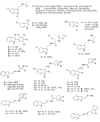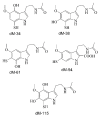Potentiating the Benefits of Melatonin through Chemical Functionalization: Possible Impact on Multifactorial Neurodegenerative Disorders
- PMID: 34769013
- PMCID: PMC8583879
- DOI: 10.3390/ijms222111584
Potentiating the Benefits of Melatonin through Chemical Functionalization: Possible Impact on Multifactorial Neurodegenerative Disorders
Abstract
Although melatonin is an astonishing molecule, it is possible that chemistry will help in the discovery of new compounds derived from it that may exceed our expectations regarding antioxidant protection and perhaps even neuroprotection. This review briefly summarizes the significant amount of data gathered to date regarding the multiple health benefits of melatonin and related compounds. This review also highlights some of the most recent directions in the discovery of multifunctional pharmaceuticals intended to act as one-molecule multiple-target drugs with potential use in multifactorial diseases, including neurodegenerative disorders. Herein, we discuss the beneficial activities of melatonin derivatives reported to date, in addition to computational strategies to rationally design new derivatives by functionalization of the melatonin molecular framework. It is hoped that this review will promote more investigations on the subject from both experimental and theoretical perspectives.
Keywords: DNA repair; antioxidant; free radical scavengers; metal chelators; multifactorial diseases; multifunctional drugs; neuroprotection; oxidative stress.
Conflict of interest statement
The authors declare no conflict of interest.
Figures









Similar articles
-
Melatonin and Related Compounds as Antioxidants.Mini Rev Med Chem. 2024;24(5):546-565. doi: 10.2174/1389557523666230627140816. Mini Rev Med Chem. 2024. PMID: 37366352 Review.
-
New melatonin-cinnamate hybrids as multi-target drugs for neurodegenerative diseases: Nrf2-induction, antioxidant effect and neuroprotection.Future Med Chem. 2015;7(15):1961-9. doi: 10.4155/fmc.15.99. Epub 2015 Oct 23. Future Med Chem. 2015. PMID: 26496465
-
Melatonin as a structural template in the development of novel drugs for neurodegenerative disorders.Ceska Slov Farm. 2018 Summer;67(2):51-58. Ceska Slov Farm. 2018. PMID: 30189733 English.
-
Melatonin: A Versatile Protector against Oxidative DNA Damage.Molecules. 2018 Feb 27;23(3):530. doi: 10.3390/molecules23030530. Molecules. 2018. PMID: 29495460 Free PMC article. Review.
-
Antioxidant properties of melatonin and its potential action in diseases.Curr Top Med Chem. 2015;15(9):894-903. doi: 10.2174/1568026615666150220120946. Curr Top Med Chem. 2015. PMID: 25697560 Review.
Cited by
-
Tunneling nanotubes and mesenchymal stem cells: New insights into the role of melatonin in neuronal recovery.J Pineal Res. 2022 Aug;73(1):e12800. doi: 10.1111/jpi.12800. Epub 2022 Apr 22. J Pineal Res. 2022. PMID: 35419879 Free PMC article. Review.
-
CADMA-Chem: A Computational Protocol Based on Chemical Properties Aimed to Design Multifunctional Antioxidants.Int J Mol Sci. 2022 Oct 31;23(21):13246. doi: 10.3390/ijms232113246. Int J Mol Sci. 2022. PMID: 36362034 Free PMC article.
-
Melatonin as a multifunctional modulator: emerging insights into its role in health, reproductive efficiency, and productive performance in livestock.Front Physiol. 2024 Dec 5;15:1501334. doi: 10.3389/fphys.2024.1501334. eCollection 2024. Front Physiol. 2024. PMID: 39703668 Free PMC article. Review.
-
Use of Cyrene™, as an alternative to dimethyl sulfoxide, as a diluent for Melatonin to determine its in vitro antimicrobial capacity.Arch Microbiol. 2024 Oct 9;206(11):427. doi: 10.1007/s00203-024-04151-9. Arch Microbiol. 2024. PMID: 39382703 Free PMC article.
-
The role of mitochondrial transfer via tunneling nanotubes in the central nervous system: A review.Medicine (Baltimore). 2024 Mar 1;103(9):e37352. doi: 10.1097/MD.0000000000037352. Medicine (Baltimore). 2024. PMID: 38428884 Free PMC article. Review.
References
-
- Reiter R.J. Circannual reproductive rhythms in mammals related to photoperiod and pineal function: A review. Chronobiologia. 1974;1:365–395. - PubMed
Publication types
MeSH terms
Substances
LinkOut - more resources
Full Text Sources
Medical

